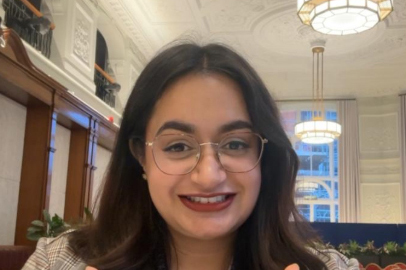BLSA President Maria Rubbani is leading with a vision built on community, academic experience, and welfare. From strengthening alumni links and piloting neurodivergent-inclusive teaching guidelines, to improving accessibility and online support, her collaborative approach is helping create a more connected and inclusive student community across Barts and The London.
When she introduces herself, Maria Rubbani laughs a little at how complicated it sounds: technically she is a fifth-year medic, but she first trained as a pharmacist, worked through the COVID-19 pandemic, and then transitioned into medicine through the graduate-entry MBBS programme. This unusual pathway has shaped her sense of responsibility and resilience. “Pharmacy gave me a grounding in science and patient care,” she explains, “but I realised I wanted to take on more of the decision-making in the clinical team.”
That determination to do more runs through Maria’s presidency of the Barts and The London Students’ Association (BLSA). She describes her vision for the year as rooted in three domains of work: community building, academic experience, and welfare. Each, she stresses, is interlinked. “You can’t improve student life by looking at one area in isolation. We have to think about how these domains come together.”
Community building
For Maria, community is about making sure students feel they belong, whatever their background or circumstances. She highlights the role of societies, volunteer groups, and peer networks in strengthening that sense of belonging. This year, the BLSA is also working on a scheme to connect alumni across the globe, complete with a new look and decorations to make the initiative more visible to students. Alongside this, a separate campaign invites students to experience snippets of different cultures and communities from around the world, further broadening that sense of connection. By encouraging collaboration across different groups and linking current students with past graduates, Maria hopes to build a stronger, more inclusive community that stretches well beyond campus.
Accessibility and neurodivergence
Maria emphasises that accessibility runs through every part of the student experience. Some challenges are structural — historic buildings and funding constraints have slowed progress on accessibility — but she is determined to act on what can be improved now. QR codes are being introduced across campus so students can easily report safety or access issues, and a contemplation space has been trialled in the recovery room to offer an accessible place for prayer or reflection. “There’s not always a permanent solution,” she acknowledges, “but it matters that students know their wellbeing is being taken seriously.”
At the same time, she has drawn on her experience as a Disability and Specific Learning Differences Representative to co-develop neurodivergent-inclusive teaching and learning guidelines with academic colleagues. These address practical aspects such as lecture organisation, slide design, and workshop delivery, and are currently at an early drafting stage. She notes that the next step will be to pilot them more widely: “Ideally, we’d like to trial them across several schools, but even introducing them in one school would make a real difference.”
Supporting online students
Maria also recognises that not all students experience university in the same way. For some, commuting daily to campus is not possible, and she emphasises that welfare and academic support need to reflect this reality. Reliably captioned lecture recordings, she notes, are a vital resource for those balancing distance, health, or personal circumstances alongside their studies. Ensuring such provisions are in place is part of her broader commitment to inclusion: making sure every student, whether on site every day or not, can access learning and feel part of the BLSA community.
Collaboration and student leadership
Maria resists the idea of leadership as an individual effort. Instead, she describes her presidency as collaborative by design. “I have a board of very capable individuals… Many of our priorities overlap, so we share responsibility while also supporting each other’s professional growth.”
This ethos extends well beyond her immediate team. Sabbatical officers across the Students’ Union are, she notes, keen to join forces when their areas overlap. Faculty staff in FMD have been proactive in supporting initiatives, and societies and volunteer groups are also deeply engaged. “It’s a very lucky overlap,” Maria reflects. “Rather than working separately, we put our heads together. That makes such a difference to what we can achieve.”
Looking back and ahead
As she reflects on her first months in office, Maria returns often to the theme of gratitude. She is realistic about the scale of the challenges ahead, but she takes confidence from the people around her. “I feel genuinely lucky this year,” she says. “Everyone I’m working with is proactive and engaged, and the overlaps in what we all want to improve show how much our experiences resonate across the faculty. That makes me believe this will be a very fruitful year.”
Her vision for community, academic experience, and welfare may sound ambitious, but the way she describes it is grounded and practical: breaking down big issues into smaller, tangible steps, and working with others to make progress together. In doing so, Maria captures the essence of what it means to lead the BLSA — not from above, but alongside.
